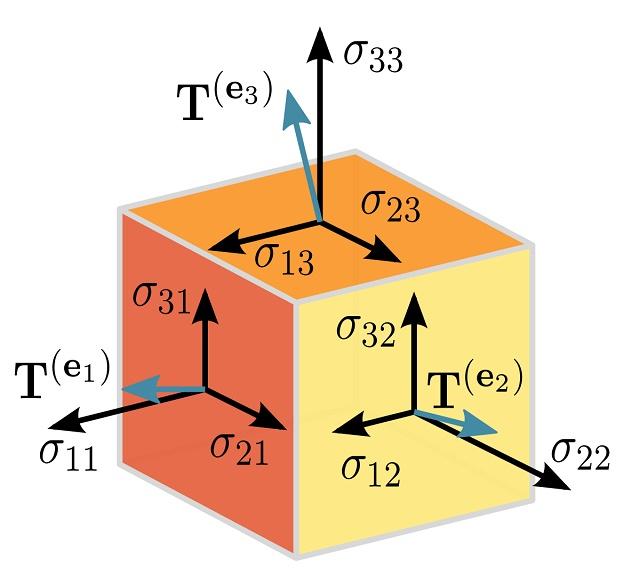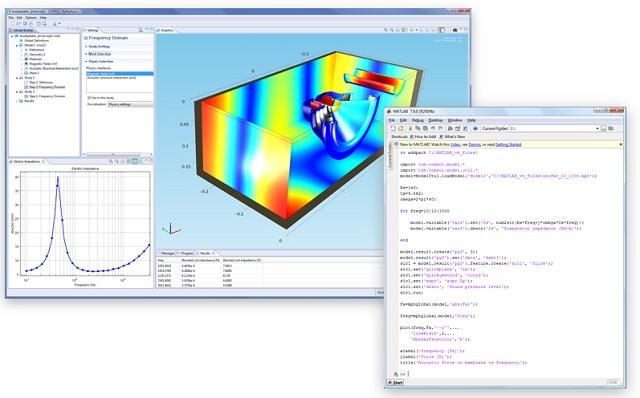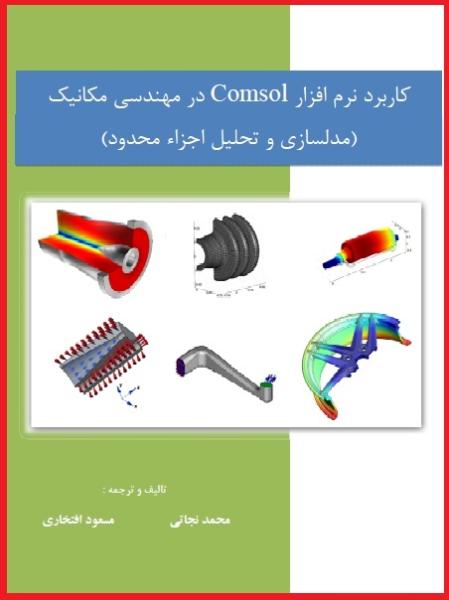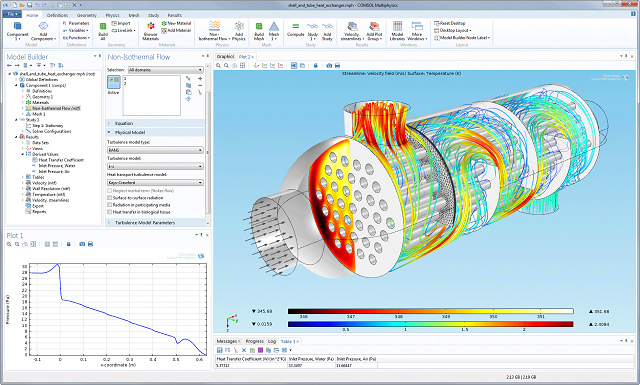
برتر فایل
مجموعه فایل های آموزش مقدماتی تا پیشرفته نرم افزار کتیا (CATIA) و مجموعه کتب, جزوات, پروژه و مقالات تخصصی مهندسی مکانیک
برتر فایل
مجموعه فایل های آموزش مقدماتی تا پیشرفته نرم افزار کتیا (CATIA) و مجموعه کتب, جزوات, پروژه و مقالات تخصصی مهندسی مکانیککتاب تانسورها (ریاضیات نظریه نسبیت و مکانیک پیوسته)
این کتاب به تجزیه و تحلیل انواع مختلف تانسورها می پردازد. فصل اول این کتاب به جبر تانسوری یا به عبارت دیگر به جبر چند بعدی در یک میدان عمومی (F) مربوط می شود. فصل دوم زمینه جبری را به مجموعه ای از اعداد حقیقی (R) محدود می نماید. سایر فصول کتاب در ادامه پایین قابل مشاهده و پیگیری می باشد. بطور خلاصه این کتاب در تکمیل مطالب مربوط به فصل تانسورها که در درس مکانیک محیط های پیوسته بیان می گردد می تواند مفید واقع گردد...

کتاب تانسورها - ریاضیات نظریه نسبیت و مکانیک پیوسته (Tensors - The Mathematics of Relativity Theory and Continuum Mechanics)، مشتمل بر 300 صفحه، در 7 فصل، با فرمت PDF، به زبان انگلیسی، همراه با مثال ها و تمرینات متعدد به ترتیب زیر گردآوری شده است:
Chapter 1: Finite Dimensional Vector Spaces and Linear Mappings
- Fields
- Finite-Dimensional Vector Spaces
- Linear Mappings of a Vector Space
- Dual or Covariant Vector Spaces
Chapter 2: Tensor Algebra
- Second-Order Tensors
- Higher Order Tensors
- Exterior or Grassmann Algebra
- Inner Product Vector Spaces and the
- Metric Tensor
Chapter 3: Tensor Analysis on a Differentiable Manifold
- Differentiable Manifolds
- Tangent Vectors, Cotangent Vectors, and Parametrized Curves
- Tensor Fields over Differentiable Manifolds
- Differential Forms and Exterior Derivatives
Chapter 4: Differentiable Manifolds with Connections
- The Affine Connection and Covariant Derivative
- Covariant Derivatives of Tensors along a Curve
- Lie Bracket, Torsion, and Curvature Tensor
Chapter 5: Riemannian and Pseudo-Riemannian Manifolds
- Metric Tensor, Christoffel Symbols and Ricci Rotation Coefficients
- Covariant Derivatives and the Curvature Tensor
- Curves, Frenet Serret Formulas and Geodesics
- Special Coordinate Charts
Chapter 6: Special Riemannian and Pseudo-Riemannian Manifolds
- Flat Manifolds
- The Space of Constant Curvature
- Einstein Spaces
- Conformally Flat Spaces
Chapter 7: Hypersurfaces, Submanifolds, and Extrinsic Curvature
- Two-Dimensional Surfaces Embedded in a Three Dimensional Space
- (N −1)-Dimensional Hypersurface
- D-Dimensional Submanifolds

کتاب تانسورها (ریاضیات نظریه نسبیت و مکانیک پیوسته)
کتاب مقدمه ای بر مکانیک محیط های پیوسته
این کتاب درسی به صورت متعادل و با استفاده از ترمودینامیک، رفتار جامدات و مایعات را بررسی می نماید. در این کتاب همچنین مطالب ریاضیات پیشرفته جهت فهم بهتر فصل های اولیه کتاب ارائه شده است. این کتاب مشتمل بر 150 تمرین و همچنین حاوی مثال های کاربردی زیادی می باشد...
کتاب مقدمه ای بر مکانیک محیط های پیوسته (Introduction to Continuum Mechanics)، مشتمل بر 252 صفحه، در 14 فصل، با فرمت PDF، به زبان انگلیسی، همراه با مثال ها و تمرینات متعدد به ترتیب زیر گردآوری شده است:
Chapter 1: Introduction
- Concept of a Continuum
- Sequence of Topics
Chapter 2: Cartesian Tensors
- Index Notation and Summation Convention
- Kronecker Delta and Permutation Symbol
- Example: Skew Symmetry
- Example: Products
- Coordinate System
- Coordinate Transformations
- Vectors
- Tensors
- Examples of Tensors
- Quotient Rule
- Inner Products: Notation
- Quadratic Forms and Eigenvalue Problems
- Example: Eigenvalue Problem
- Diagonalization and Polar Decomposition
- Example: Polar Decomposition
Chapter 3: General Tensors
- Vectors and Tensors
- Physical Components
- Tensor Calculus
- Curvature Tensors
- Applications
- Example: Incompressible Flow
- Example:Equilibrium of Stresses
Chapter 4: Integral Theorems
- Gauss Theorem
- Stokes Theorem
Chapter 5: Deformation
- Lagrangian and Eulerian Descriptions
- Deformation Gradients
- Deformation Gradient Vectors
- Curvilinear Systems
- Strain Tensors
- Decomposition of Displacement Gradients
- Stretch
- Extension
- Infinitesimal Strains and Rotations
- Deformation Ellipsoids
- Polar Decomposition of the Deformation Gradient
- Stretch and Rotation
- Example: Polar Decomposition
- Example: Square Root of a Matrix
- Logarithmic Strain
- Change of Volume
- Change of Area
- Compatibility Equations
- Spatial Rotation and Two-Point Tensors
- Curvilinear Coordinates
Chapter 6: Motion
- Material Derivative
- Some Terminology
- Example: Path Line, Stream Line, and Streak Line
- Length, Volume, and Area Elements
- Length
- Volume
- Area
- Material Derivatives of Integrals
- Line Integrals
- Area Integrals
- Volume Integrals
- Deformation Rate, Spin, and Vorticity
- Strain Rate
- Rotation Rate of Principal Axis
Chapter 7: Fundamental Laws of Mechanics
- Mass
- Conservation and Balance Laws
- Conservation of Mass
- Balance of Linear Momentum
- Balance of Angular Momentum
- Balance of Energy
- Entropy Production
- Axiom of Material Frame Indifference
- Objective Measures of Rotation
- Integrity Basis
Chapter 8: Stress Tensor
- External Forces and Moments
- Internal Forces and Moments
- Cauchy Stress and Couple Stress Tensors
- Transformation of the Stress Tensor
- Principal Stresses
- Shear Stress
- Hydrostatic Pressure and Deviatoric Stresses
- Objective Stress Rates
- Local Conservation and Balance Laws
- Conservation of Mass
- Balance of Linear Momentum
- Balance of Moment of Momentum (Angular Momentum)
- Material Description of the Equations of Motion
- First Piola–Kirchhoff Stress Tensor
- Second Piola–Kirchhoff Stress Tensor
Chapter 9: Energy and Entropy Constraints
- Classical Thermodynamics
- Balance of Energy
- Clausius–Duhem Inequality
- Fourier’s Law of Heat Conduction
- Newton’s Law of Viscosity
- Onsager’s Principle
- Strain Energy Density
- Ideal Gas
- Internal Energy
- Legendre or Contact Transformation
- Surface Energy
- Method of Jacobians in Thermodynamics
Chapter 10: Constitutive Relations
- Invariance Principles
- Principles of Exclusion
- Principle of Coordinate Invariance
- Principle of Spatial Invariance
- Principle of Material Invariance
- Principle of Dimensional Invariance
- Principle of Consistency
- Simple Materials
- Elastic Materials
- Elastic Materials of Cauchy
- Elastic Materials of Green
- Stokes Fluids
- Invariant Surface Integrals
- Singularities
Chapter 11: Hyperelastic Materials
- Finite Elasticity
- Homogeneous Deformation
- Simple Extension
- Hydrostatic Pressure
- Simple Shear
- Torsion of a Circular Cylinder
- Approximate Strain Energy Functions
- Hookean Materials
- Small-Strain Approximation
- Plane Stress and Plane Strain
- Integrated Elasticity
- Example: Incremental Loading
- A Variational Principle for Static Elasticity
- Isotropic Thermoelasticity
- Specific Heats and Latent Heats
- Strain Cooling
- Adiabatic and Isothermal Elastic Modulus
- Example: Rubber Elasticity
- Linear Anisotropic Materials
- Invariant Integrals
Chapter 12: Fluid Dynamics
- Basic Equations
- Approximate Constitutive Relations
- Newtonian Fluids
- Inviscid Fluids
- Shearing Flow
- Pipe Flow
- Rotating Flow
- Navier–Stokes Equations
- Incompressible Flow
- Compressible Flow
- Inviscid Flow
- Speed of Sound
- Method of Characteristics
- Bernoulli Equation
- Invariant Integrals
Chapter 13: Viscoelasticity
- Kelvin–Voigt Solid
- Maxwell Fluid
- Standard Linear Solid
- Superposition Principle
- Constitutive Laws in the Operator Form
- Three-Dimensional Linear Constitutive Relations
- Anisotropy
- Biot’s Theory
- Minimum Entropy Production Rate
- Creep in Metals
- Nonlinear Theories of Viscoelasticity
- K-BKZ Model for Viscoelastic Fluids
Chapter 14: Plasticity
- Idealized Theories
- Rigid Perfectly Plastic Material
- Elastic Perfectly Plastic Material
- Elastic Linearly Hardening Material
- Three-Dimensional Theories
- Postyield Behavior
- Levy–Mises Flow Rule
- Prandtl–Reuss Flow Rule
- General Yield Condition and Plastic Work
- Plane Stress and Plane Strain
- Rigid Plasticity and Slip-Line Field
- Example: Symmetric External Cracks
- Drucker’s Definition of Stability
- Il´ıushin’s Postulate
- Work-Hardening Rules
- Perfectly Plastic Material
- Isotropic Hardening
- Kinematic Hardening
- Hencky’s Deformation Theory
- Endochronic Theory of Valanis
- Plasticity and Damage
- Minimum Dissipation Rate Principle

کتاب مقدمه ای بر مکانیک محیط های پیوسته
کتاب مقدمه ای بر مکانیک محیط های پیوسته
پروفسور جی ان ردی یک استاد برجسته در دانشکده مهندسی مکانیک دانشگاه تگزاس می باشد. این استاد برجسته در سطح بین المللی به خاطر تبحر در علوم مکانیک محاسباتی و مکانیک کاربردی و همچنین تالیف 17 کتاب و ارائه بیش از 450 مقاله در ژورنال های مختلف علمی شناخته شده می باشد. کتاب مقدمه ای بر مکانیک محیط های پیوسته پروفسور ردی فرم غیرمادی و جزء را معرفی می نماید. در این کتاب فرم معادلات اساسی و برنامه های کاربردی آنها به مشکلات در کشش، مکانیک سیالات، و انتقال حرارت و معرفی مختصر به ویسکوالاستیک خطی را نیز ارائه می دهد. این کتاب برای دانشجویان تحصیلات تکمیلی بسیار ایده آل می باشد. همچنین این کتاب برای کسانی که به دنبال کار بیشتر در زمینه های دینامیک سیالات، انعطاف پذیری، صفحات و پوسته ها، ویسکوزولاسیون، پلاستیک و زمینه های بین رشته ای مانند ژئومکانیک، بیومکانیک، مکانیولوژی و علوم نانو هستند می تواند مفید واقع گردد...

کتاب مقدمه ای بر مکانیک محیط های پیوسته (Introduction to Continuum Mechanics)، مشتمل بر 480 صفحه، در 9 فصل، با فرمت PDF، به زبان انگلیسی، همراه با مثال ها و تمرینات متعدد به ترتیب زیر گردآوری شده است:
Chapter 1: Introduction
- Continuum Mechanics
- A Look Forward
- Summary
- Problems
Chapter 2: VECTORS AND TENSORS
- Background and Overview
- Vector Algebra
- Definition of a Vector
- Vector addition
- Multiplication of a vector by a scalar
- Linear independence of vectors
- Scalar and Vector Products
- Scalar product
- Vector product
- Triple products of vectors
- Plane Area as a Vector
- Reciprocal Basis
- Components of a vector
- General basis
- Ortho normal basis
- The Gram–Schmidt ortho normalization
- Summation Convention
- Dummy index
- Free index
- Kronecker delta
- Permutation symbol
- Transformation Law for Different Bases
- General transformation laws
- Transformation laws for orthonormal systems
- Theory of Matrices
- Definition
- Matrix Addition and Multiplication of a Matrix by a Scalar
- Matrix Transpose
- Symmetric and Skew Symmetric Matrices
- Matrix Multiplication
- Inverse and Determinant of a Matrix
- Positive-Definite and Orthogonal Matrices
- Vector Calculus
- Differentiation of a Vector with Respect to a Scalar
- .Curvilinear Coordinates
- The Fundamental Metric
- Derivative of a Scalar Function of aVector
- The Del Operator
- Divergence and Curl of a Vector
- Cylindrical and Spherical Coordinate Systems
- Gradient, Divergence, and Curl Theorems
- Tensors
- Dyads and Dyadics
- Nonion Form of a Second-Order Tensor
- Transformation of Components of a Tensor
- Higher-Order Tensors
- Tensor Calculus
- Eigenvalues and Eigenvectors
- Eigenvalue problem
- Eigenvalues and eigen vectors of a real symmetric tensor
- Spectral theorem
- Calculation of eigenvalues and eigen vectors
- Summary
- Problems
Chapter 3: KINEMATICS OF CONTINUA
- Introduction
- Descriptions of Motion
- Configurations of a Continuous Medium
- Material Description
- Spatial Description
- Displacement Field
- Analysis of Deformation
- Deformation Gradient
- Isochoric, Homogeneous, and In homogeneous Deformation
- Isochoric deformation
- Homogeneous deformation
- Nonhomogeneous deformation
- Change of Volume and Surface
- Volume change
- Area change
- Strain Measures
- Cauchy Green Deformation Tensors
- Green Lagrange Strain Tensor
- Physical Interpretation of Green–Lagrange Strain Components
- Cauchy and Euler Strain Tensors
- Transformation of Strain Components
- Invariants and Principal Values of Strains
- Infinitesimal Strain Tensor and Rotation Tensor
- Infinitesimal Strain Tensor
- Physical Interpretation of Infinitesimal Strain
- Tensor Components
- Infinitesimal Rotation Tensor
- Infinitesimal Strains in Cylindrical and Spherical
- Coordinate Systems
- Cylindrical coordinate system
- Spherical coordinate system
- Velocity Gradient and Vorticity Tensors
- Relationship Between D and ˙E
- Compatibility Equations
- Preliminary Comments
- Infinitesimal Strains
- Finite Strains
- Rigid-Body Motions and Material Objectivity
- Superposed Rigid-Body Motions
- Introduction and rigid-body transformation
- Effect on F
- Effect on C and E
- Effect on L and D
- Material Objectivity
- Observer transformation
- Objectivity of various kinematic measures
- Time rate of change in a rotating frame of reference
- Polar Decomposition Theorem
- Preliminary Comments
- Rotation and Stretch Tensors
- Objectivity of Stretch Tensors
- Summary
- Problems
Chapter 4: STRESS MEASURES
- Introduction
- Cauchy Stress Tensor and Cauchy’s Formula
- Stress Vector
- Cauchy’s Formula
- Cauchy Stress Tensor
- Transformation of Stress Components and Principal Stresses
- Transformation of Stress Components
- Invariants
- Transformation equations
- Principal Stresses and Principal Planes
- Maximum Shear Stress
- Other Stress Measures
- Preliminary Comments
- First Piola Kirchhoff Stress Tensor
- Second Piola Kirchhoff Stress Tensor
- Equilibrium Equations for Small Deformations
- Objectivity of Stress Tensors
- Cauchy Stress Tensor
- First Piola Kirchhoff Stress Tensor
- Second Piola Kirchhoff Stress Tensor
- Summary
- Problems
Chapter 5: CONSERVATION AND BALANCE LAWS
- Introduction
- Conservation of Mass
- Preliminary Discussion
- Material Time Derivative
- Vector and Integral Identities
- Vector identities
- Integral identities
- Continuity Equation in the Spatial Description
- Continuity Equation in the Material Description
- Reynolds Transport Theorem
- Balance of Linear and Angular Momentum
- Principle of Balance of Linear Momentum
- Equations of motion in the spatial description
- Equations of motion in the material description
- Spatial Equations of Motion in Cylindrical and Spherical Coordinates
- Cylindrical coordinates
- Spherical coordinates
- Principle of Balance of Angular Momentum
- Mono polar case
- Multi polar case
- Thermodynamic Principles
- Balance of Energy
- Energy equation in the spatial description
- Energy equation in the material description
- Entropy Inequality
- Homogeneous processes
- In homogeneous processes
- Conservation and Balance Equations in the Spatial Description
- Conservation and Balance Equations in the Material Description
- Closing Comments
- Problems
Chapter 6: CONSTITUTIVE EQUATIONS
- Introduction
- General Comments
- General Principles of Constitutive Theory
- Material Frame Indifference
- Restrictions Placed by the Entropy Inequality
- Elastic Materials
- Cauchy Elastic Materials
- Green-Elastic or Hyper elastic Materials
- Linearized Hyper elastic Materials: Infinitesimal Strains
- Hookean Solids
- Generalized Hooke’s Law
- Material Symmetry Planes
- Monoclinic Materials
- Orthotropic Materials
- Isotropic Materials
- Nonlinear Elastic Constitutive Relations
- Newtonian Fluids
- Ideal Fluids
- Viscous In compressible Fluids
- Generalized Newtonian Fluids
- Inelastic Fluids
- Power law model
- Carreau model
- Bingham model
- Visco elastic Constitutive Models
- Differential models
- Integral models
- Heat Transfer
- Fourier’s Heat Conduction Law
- Newton’s Law of Cooling
- Stefan–Boltzmann Law
- Constitutive Relations for Coupled Problems
- Electro magnetics
- Maxwell’s equations
- Constitutive relations
- Thermo elasticity
- Hygro thermal elasticity
- Electro elasticity
- Summary
- Problems
Chapter 7: LINEARIZED ELASTICITY
- Introduction
- Governing Equations
- Preliminary Comments
- Summary of Equations
- Strain displacement equations
- Equations of motion
- Constitutive equations
- Boundary conditions
- Compatibility conditions
- The Navier Equations
- The Beltrami Michell Equations
- Solution Methods
- Types of Problems
- Types of Solution Methods
- Examples of the Semi Inverse Method
- Stretching and Bending of Beams
- Superposition Principle
- Uniqueness of Solutions
- Clapeyron’s, Betti’s, and Maxwell’s Theorems
- Clapeyron’s Theorem
- Betti’s Reciprocity Theorem
- Maxwell’s Reciprocity Theorem
- Solution of Two-Dimensional Problems
- Plane Strain Problems
- Plane Stress Problems
- Unification of Plane Stress and Plane Strain Problems
- Airy Stress Function
- Saint Venant’s Principle
- Torsion of Cylindrical Members
- Warping function
- Prandtl’s stress function
- Methods Based on Total Potential Energy
- The Variational Operator
- The Principle of the Minimum Total Potential Energy
- Construction of the total potential energy functional
- Euler’s equations and natural boundary conditions
- Minimum property of the total potential energy functional
- Castigliano’s TheoremI
- The Ritz Method
- The variational problem
- Description of the method
- Hamilton’s Principle
- Hamilton’s Principle for a Rigid Body
- Hamilton’s Principle for a Continuum
- Summary
- Problems
Chapter 8: FLUID MECHANICS AND HEAT TRANSFER
- Governing Equations
- Preliminary Comments
- Summary of Equations
- Fluid Mechanics Problems
- Governing Equations of Viscous Fluids
- In viscid Fluid Statics
- Parallel Flow (Navier Stokes Equations)
- Problems with Negligible Convective Terms
- Energy Equation for One-Dimensional Flows
- Heat Transfer Problems
- Governing Equations
- Heat Conduction in a Cooling Fin
- Axisymmetric Heat Conduction in a Circular Cylinder
- Two Dimensional Heat Transfer
- Coupled Fluid Flow and Heat Transfer
- Summary
- Problems
Chapter 9: LINEARIZED VISCOELASTICITY
- Introduction
- Preliminary Comments
- Initial Value Problem, the Unit Impulse, and the Unit Step Function
- The Laplace Transform Method
- Spring and Dashpot Models
- Creep Compliance and Relaxation Modulus
- Maxwell Element
- Creep response
- Relaxation response
- Kelvin Voigt Element
- Creep response
- Relaxation response
- Three Element Models
- Four Element Models
- Integral Constitutive Equations
- Hereditary Integrals
- Hereditary Integrals for Deviatoric Components
- The Correspondence Principle
- Elastic and Viscoelastic Analogies
- Summary
- Problems

کتاب مقدمه ای بر مکانیک محیط های پیوسته
کتاب تشریح کامل مسائل مکانیک محیط های پیوسته برای مهندسان
کتاب تشریح کامل مسائل مکانیک محیط های پیوسته برای مهندسان، مشتمل بر 220 صفحه، با فرمت PDF، به زبان فارسی، زیر نظر دکتر عباس راستگو، به ترتیب زیر گردآوری شده است:
ریاضیات ضروری
اصول تنش
سینماتیک تغیر شکل و حرکت
قوانین و معادلات بنیادین
الاستیسیته خطی
شاره های کلاسیک
در این کتاب شما با نحوه حل دقیق مسائل مکانیک محیط های پیوسته (Continuum Mechanics) با زبان گویا آشنا شده و با تمرین و ممارست می توانید به راحتی هر مسئله مکانیک محیط های پیوسته را حل نمایید.

کتاب تشریح کامل مسائل مکانیک محیط های پیوسته برای مهندسان
کتاب آموزش طراحی و شبیه سازی پروژه های مهندسی با نرم افزار COMSOL Multiphysics
با استفاده از نرم افزار COMSOL Multiphysics می توان طراحی و شبیه سازی پروژه های مهندسی برق، مکانیک، علوم زمین، شیمی، فیزیک، نجوم و کوانتوم را انجام داد. این نرم افزار یک مجموعه شبیه سازی است که می تواند معادلات دیفرانسیل سیستم های غیر خطی را توسط مشتق های جزئی روش المان محدود در فضاهای یک، دو و سه بعدی حل نماید. این نرم افزار می تواند در حضور چالش هایی نظیر میدان های الکترومغناطیسی، کشش، دینامیک سیالات و دینامیک گاز به خوبی راه گشا باشد. همچنین این برنامه امکان تعامل با نرم افزارهای مهندسی دیگر مانند MATLAB و CATIA را دارد و نیز نام قبلی این نرم افزار Femlab بوده است.
قابلیت های نرم افزار COMSOL Multiphysics عبارتند از:
- طراحی و شبیه سازی پروژه های مهندسی برق، مکانیک، علوم زمین، شیمی، فیزیک، نجوم و کوانتوم
- حل معادلات دیفرانسیل سیستم های غیر خطی، توسط مشتق های جزئی روش المان محدود در فضاهای یک، دو و سه بعدی
- راه گشای خوبی در حضور چالش هایی نظیر میدان های الکترو مغناطیسی، کشش، دینامیک سیالات و دینامیک گاز
- امکان تعامل با نرم افزارهای مهندسی دیگر مانند MATLAB و CATIA
- قابلیت نصب بر روی ویندوز های ۳۲ بیتی و ۶۴ بیتی
- قابلیت نصب در سیستم عامل Mac OS و Linux و …

کتاب آموزش طراحی و شبیه سازی پروژه های مهندسی با نرم افزار COMSOL Multiphysics، یکی از کتاب های مفید و کاربردی در زمینه آموزش نرم افزار شبیه ساز کامسول می باشد. در این مجموعه آموزشی شما قادر خواهید بود اولا نسخه اصلی کتاب به زبان لاتین (MultiPhysics Modeling using Comsol)، ثانیا کتاب کاربرد نرم افزار کامسول در مهندسی مکانیک (مدل سازی و تحلیل اجزاء محدود) به زبان فارسی را بطور کامل دانلود نمایید.

کتاب آموزش طراحی و شبیه سازی پروژه های مهندسی با نرم افزار COMSOL Multiphysics، مشتمل بر 10 فصل، 872 صفحه، با فرمت pdf، به زبان انگلیسی، همراه با تصاویر، به ترتیب زیر گردآوری شده است:
Chapter 1: Modeling Methodology
Chapter 2: Materials and Databases
Chapter 3: 1D Modeling
Chapter 4: 2D Modeling
Chapter 5: 2D Axisymmetric Modeling
Chapter 6: 2D Simple Mixed-Mode Modeling
Chapter 7: 2D Complex Mixed-Mode Modeling
Chapter 8: 3D Modeling
Chapter 9: Perfectly Matched Layer Models
Chapter 10: Bioheat Models

کتاب کاربرد نرم افزار کامسول در مهندسی مکانیک (مدل سازی و تحلیل اجزاء محدود)، مشتمل بر 7 فصل، 144 صفحه، با فرمت pdf، به زبان فارسی، همراه با تصاویر، به ترتیب زیر گردآوری شده است:
فصل 1: تعریف روند مدل سازی و تحلیل در نرم افزار
- COMSOL Multiphysics
- Model Navigator
- Options
- ایجاد مدل ھندسی
- تنظیمات Subdomain
- تعیین شرایط مرزی
- ایجاد مش
- انتخاب یک حل کننده
- پردازش نتایج در سه بعد
- مراجع
فصل 2: آنالیزھای مختلف از یک زانویی یک سرگیردار
- معرفی
- آنالیز استاتیکی
- آنالیز فرکانس ویژه
- آنالیز گذرا
- آنالیز پاسخ فرکانسی
- آنالیز پارامتری
- اثر متقابل سازه ای حرارتی با انتقال حرارت گذرا
فصل 3: تولید گرما در یک سازه تحت ارتعاش
- معرفی
- نتایج و بحث
- مسیر انتخاب آنالیز در نرم افزار
- مراجع
فصل 4: ریخته گری پیوسته
- تعریف
- مسیر انتخاب آنالیز در نرم افزار
- مدلسازی ھندسی
- شرایط
- ایجاد
- حل مسئله
- مراجع
فصل 5: جریان آشفته در سرتاسر لوله و بدنه یک مبدل حرارتی
- معرفی
- تعریف
- مسیر انتخاب آنالیز در نرم افزار
- مدلسازی ھندسی
- تنظیمات فیزیکی و مرزی
- ایجاد مش
- حل مسئله
- پس پردازش
- مراجع
فصل 6: اثر متقابل سیال سازه ای در اکستروژن آلومینیوم
- معرفی
- تعریف مدل
- آنالیز سازه ای
- آنالیز انتقال حرارت
- سیال غیر نیوتنی
- نتایج و بحث
- مسیر انتخاب آنالیز در نرم افزار
- تنظیمات
- مدلسازی ھندسی
- تنظیمات فیزیکی
- شرایط مرزی جریان غیر نیوتنی
- شرایط مرزی مکانیک سازه ای
- شرایط مرزی انتقال حرارت
- ایجاد مش
- حل مسئله
- پس پردازش
- مراجع
فصل 7: آنالیز ارتعاشی روتور
- معرفی
- مسیر انتخاب آنالیز در نرم افزار
- مدلسازی ھندسی
- شرایط مرزی
- ایجاد مش
- حل مسئله
- پیش پردازش
